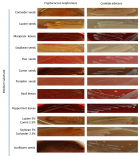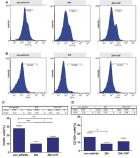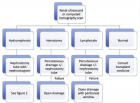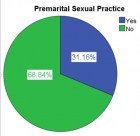Abstract
Research Article
Medicinal plant Potentilla fulgens and its effect in vitro against Fasciola gigantica
Pradeep Kumar*
Published: 13 May, 2021 | Volume 5 - Issue 1 | Pages: 004-007
Fascioliasis is a one of the most important serious parasitic zoonotic disease which caused by trematode giant liver fluke Fasciola hepatica and F. gigantica among cattle’s and humans. The infection of Fasciola can be control by the use of phytochemicals as anthelmintic components. The anthelmintic activities of dried root powder of medicinal plant Potentilla fulgens and their different preparations (organic extracts and column purified fraction) are uses in vitro against liver fluke F. gigantica. The dried root powder, different organic extract, and column fractions were time and concentration-dependent. Among all the organic extracts, ethanol extract was high toxic than other organic extracts. The toxic effect of ethanolic extract of P. fulgens after 2h exposure the LC50 value is 5.22 mg/ml against F. gigantica. The column purified fraction of dried root powder of P. fulgens shows more toxicity. The 2h LC50 of column purified fraction was 3.25 mg/ml whereas in 8h exposure the LC50 is 1.24 mg/ml. The phytochemicals of the P. fulgens may be used as anthelmintic components against liver fluke F. gigantica.
Read Full Article HTML DOI: 10.29328/journal.icci.1001018 Cite this Article Read Full Article PDF
Keywords:
Potentilla fulgens; Fasciola gigantica; Fascioliasis; Anthelmintic activity
References
- Phalee A, Wongsawad C, Rojanapaibul A, Chai J. Experimental life history and biological characteristics of Fasciola gigantica (Digenea: Fasciolidae). Korean J Parasitol. 2015; 53: 59-64. PubMed: https://pubmed.ncbi.nlm.nih.gov/25748710/
- Chen JX, Chen MX, Ai L, Xu XN, Jiao JM. An Outbreak of Human Fascioliasis gigantica in Southwest China. PLoS ONE. 2013; 8: 71520. PubMed: https://pubmed.ncbi.nlm.nih.gov/23951181/
- Kuchai JA, Chisnti MZ, Zaki MM, Rasool SAM, Ahmad J, et al. Some epidemiological aspects of fascioliasis among cattle of Ladakh. Global Vet. 2011; 7: 342-346.
- Eshetu EN, Thomas A, Awukew A, Goa, Buyako B. Study on the prevalence of Bovine Fascioliasis and Estimated financial loss due to liver condemnation: In case of Angacha Woreda, Kambata Tembaro Zone, Southern Ethiopia. J Biol Agric Healthcare. 2017; 7: 78-83.
- Singh O, Agarwal RA. Toxicity of certain pesticides to two economic species of snails in northern India. J Economic Entomol. 1981; 74: 568-571.
- Kumar P, Singh DK. Molluscicidal activity of Ferula asafoetida, Syzygium aromaticum and Carum carvi and their active components against the snail Lymnaea acuminata. Chemosphere. 2006; 63: 1568-1574. PubMed: https://pubmed.ncbi.nlm.nih.gov/16310827/
- Singh V, Singh DK. The effect of abiotic factors on the toxicity of cypermethrin against the snail Lymnaea acuminata in the control of fascioliasis. J Helminthol. 2009; 83: 39-45.
- Kumar P, Singh VK, Singh DK. Enzyme activity in the nervous tissue of Lymnaea acuminata fed to different bait formulations. Am J Chem. 2012; 2: 89-93.
- Singh RN, Kumar P, Kumar N, Singh DK. Efficacy of binary combination of deltamethrin+MGK-264 on levels of biochemical changes in the snail Lymnaea acuminata. Int J Pharm Pharmaceut Sci. 2020; 12: 111-116.
- Vishwakarma AK, Kumar P. In vivo Anthelmintic Activity of Medicinal plant Asparagus racemosus against Larva of Fasciola gigantica. Res J Agri Sci. 2021; 12: 675-680.
- Ghoneim MA, El-kirdasy AF, Goher AK, Moussa WM, El-Ballal SS, et al. Expression of cathepsin L1 Gene of Fasciola gigantica in different development stages. J Appl Sci Res. 2008; 4: 2017-2078.
- Singh D, Swarnkar CP, Khan FA. Anthelmintic resistance in gastrointestinal nematodes of livestock in India. J Vet Parasitol. 2002; 16: 115-130.
- Hammond JA, Fielding D, Bishop SC. Prospects for plant Anthelmintics in tropical veterinary medicine. Vet Res Com. 1997; 21: 213-228. PubMed: https://pubmed.ncbi.nlm.nih.gov/9090048/
- Kaul K, Jaitak V, Kaul VK. Review on pharmaceutical properties and conservation measures of Potentilla fulgens Wall. Ex Hook-a medicinal endangered herb of higher Himalaya. Indian J Nat Prod Resour. 2011; 2: 298-306.
- Kumar P, Sunita K, Singh DK. Efficacy of Potentilla fulgens root powder and their different organic extract against fresh water vector snail Lymnaea acuminata. Asian J Animal Vet Adv. 2018a; 13: 3034.
- Kumar P, Sunita K, Singh DK. Molluscicidal activity of different organic root extract of Potentilla fulgens against liver fluke vector snail Indoplanorbis exustus. Asian J Animal Sci. 2018b; 12: 30-35.
- Kumar P. Effect of medicinal plant Potentilla fulgens against fecundity, hatchability and survival of Fasciola host snail Indoplanorbis exustus. Indian J Scienti Res. 2021; 11: 19-24.
- Hajare SW, Lonare MK, Kumar D. Paralytic effect of Peganum harmala Linn. Alcoholic extract on Fasciola gigantica. J Vet Pharmacol Toxicol. 12; 11: 53-55.
- Kumar P, Singh DK. In vitro anthelmintic activity of Allium sativum, Ferula asafoetida, Syzygium aromaticum and their active components against Fasciola gigantica. J Biol Earth Sci. 2014; 4: B57-B65.
- Robertson JL, Russell RM, Preciter HK, Savin NE. Bioassay with arthropods data, 2nd Eds Taylar and Francis, CRC Press. 2007; 1-224.
- Kumar P, Sunita K, Singh RN, Singh DK. Fasciola larvae: Anthelmintic activity of medicinal plant Potentilla fulgens against sporocyst, redia and cercaria. Asian J Adv Res. 2020; 3: 24-30.
- Akhar MS, Zafar Iqbal Khan MN, Lateef M. Anthelmintic activity of medicinal plants with particular reference to their use in indo Pakistan sub continent. Small Rumin. 2000; 38: 99-107.
- Kumar P, Sunita K, Singh DK. In vitro activity of different phytochemicals in binary combinations against Fasciola gigantica. Current Life Sci. 2016; 2: 58-63.
- Hemalatha S, Laloo D, Prasad SK, Krishnamurthy S. Gastroprotective activity of ethanolic root extract of Potentilla fulgens Wall. Ex Hook. J Ethnopharmacol. 2013; 146: 505-514. PubMed: https://pubmed.ncbi.nlm.nih.gov/23384786/
- Roy B, Swargiary A, Syiem D, Tandon V. Potentilla fulgens (Family Rosaceae), a medicinal plant of North-East India: A natural anthelmintic. J Parasit Dis. 2010; 34: 83-88. PubMed: https://pubmed.ncbi.nlm.nih.gov/21966126/
- Jaitak V, Kaul VK, Himlata N, Kumar B, Singh J, Dhar, Sharma OP. New hopane triterpenes and antioxidant constituents from Potentilla fulgens. Net Prod Commun. 2010; 5: 1561-1566. PubMed: https://pubmed.ncbi.nlm.nih.gov/21121248/
- Hoste H, Jackson F, Athanasiadou S, Thamsborg SM, Hoskin SO. The effects of tannin-rich plants on parasitic nematodes in ruminants. Trends Parasitol. 2006; 22: 253-261. PubMed: https://pubmed.ncbi.nlm.nih.gov/16632404/
- Hoste H, Martinez-Ortiz-De-Montellano C, Manolaraki F, Brunet S, Ojeda-Robertos N, et al. Direct and indirect effects of bioactive tannin-rich tropical and temperate legumes against nematode infections. Vet Parasitol. 2012; 186: 18-27. PubMed: https://pubmed.ncbi.nlm.nih.gov/22188981/
- Athanasiadou S, Kyriazakis I, Jackson F, Coop RL. The effects of condensed tannins supplementation of foods with different protein content on parasitism, food intake and performance of sheep infected with Trichostrongylus colubriformis. Bri J Nutrit. 2001; 86: 697-706. PubMed: https://pubmed.ncbi.nlm.nih.gov/11749679/
- Molan AL, Waghorn GC, Mcnabb WC. Effect of condensed tannins on egg hatching and larval development of Trichostrongylus colubriformis in vitro. Vet Rec. 2002; 150: 65-69. PubMed: https://pubmed.ncbi.nlm.nih.gov/11837588/
- Rosangkima G, Prasad SB. Antitumour activity of some plants from Meghalaya and Mizoram against Murine ascites Dalton’s lymphoma. Indian J Exp Biol. 2004; 42: 981-988. PubMed: https://pubmed.ncbi.nlm.nih.gov/15511001/
- Majaw S, Challam SK, Syiem D. Effect of Potentilla fulgens L. on selective enzyme activities and altered tissue morphology in diabetic mice. J Morphol Sci. 2018; 38: 153-160.
Figures:
Similar Articles
-
Medicinal plant Potentilla fulgens and its effect in vitro against Fasciola giganticaPradeep Kumar*. Medicinal plant Potentilla fulgens and its effect in vitro against Fasciola gigantica. . 2021 doi: 10.29328/journal.icci.1001018; 5: 004-007
Recently Viewed
-
Agriculture High-Quality Development and NutritionZhongsheng Guo*. Agriculture High-Quality Development and Nutrition. Arch Food Nutr Sci. 2024: doi: 10.29328/journal.afns.1001060; 8: 038-040
-
A Low-cost High-throughput Targeted Sequencing for the Accurate Detection of Respiratory Tract PathogenChangyan Ju, Chengbosen Zhou, Zhezhi Deng, Jingwei Gao, Weizhao Jiang, Hanbing Zeng, Haiwei Huang, Yongxiang Duan, David X Deng*. A Low-cost High-throughput Targeted Sequencing for the Accurate Detection of Respiratory Tract Pathogen. Int J Clin Virol. 2024: doi: 10.29328/journal.ijcv.1001056; 8: 001-007
-
A Comparative Study of Metoprolol and Amlodipine on Mortality, Disability and Complication in Acute StrokeJayantee Kalita*,Dhiraj Kumar,Nagendra B Gutti,Sandeep K Gupta,Anadi Mishra,Vivek Singh. A Comparative Study of Metoprolol and Amlodipine on Mortality, Disability and Complication in Acute Stroke. J Neurosci Neurol Disord. 2025: doi: 10.29328/journal.jnnd.1001108; 9: 039-045
-
Development of qualitative GC MS method for simultaneous identification of PM-CCM a modified illicit drugs preparation and its modern-day application in drug-facilitated crimesBhagat Singh*,Satish R Nailkar,Chetansen A Bhadkambekar,Suneel Prajapati,Sukhminder Kaur. Development of qualitative GC MS method for simultaneous identification of PM-CCM a modified illicit drugs preparation and its modern-day application in drug-facilitated crimes. J Forensic Sci Res. 2023: doi: 10.29328/journal.jfsr.1001043; 7: 004-010
-
A Gateway to Metal Resistance: Bacterial Response to Heavy Metal Toxicity in the Biological EnvironmentLoai Aljerf*,Nuha AlMasri. A Gateway to Metal Resistance: Bacterial Response to Heavy Metal Toxicity in the Biological Environment. Ann Adv Chem. 2018: doi: 10.29328/journal.aac.1001012; 2: 032-044
Most Viewed
-
Evaluation of Biostimulants Based on Recovered Protein Hydrolysates from Animal By-products as Plant Growth EnhancersH Pérez-Aguilar*, M Lacruz-Asaro, F Arán-Ais. Evaluation of Biostimulants Based on Recovered Protein Hydrolysates from Animal By-products as Plant Growth Enhancers. J Plant Sci Phytopathol. 2023 doi: 10.29328/journal.jpsp.1001104; 7: 042-047
-
Sinonasal Myxoma Extending into the Orbit in a 4-Year Old: A Case PresentationJulian A Purrinos*, Ramzi Younis. Sinonasal Myxoma Extending into the Orbit in a 4-Year Old: A Case Presentation. Arch Case Rep. 2024 doi: 10.29328/journal.acr.1001099; 8: 075-077
-
Feasibility study of magnetic sensing for detecting single-neuron action potentialsDenis Tonini,Kai Wu,Renata Saha,Jian-Ping Wang*. Feasibility study of magnetic sensing for detecting single-neuron action potentials. Ann Biomed Sci Eng. 2022 doi: 10.29328/journal.abse.1001018; 6: 019-029
-
Pediatric Dysgerminoma: Unveiling a Rare Ovarian TumorFaten Limaiem*, Khalil Saffar, Ahmed Halouani. Pediatric Dysgerminoma: Unveiling a Rare Ovarian Tumor. Arch Case Rep. 2024 doi: 10.29328/journal.acr.1001087; 8: 010-013
-
Physical activity can change the physiological and psychological circumstances during COVID-19 pandemic: A narrative reviewKhashayar Maroufi*. Physical activity can change the physiological and psychological circumstances during COVID-19 pandemic: A narrative review. J Sports Med Ther. 2021 doi: 10.29328/journal.jsmt.1001051; 6: 001-007

HSPI: We're glad you're here. Please click "create a new Query" if you are a new visitor to our website and need further information from us.
If you are already a member of our network and need to keep track of any developments regarding a question you have already submitted, click "take me to my Query."

















































































































































